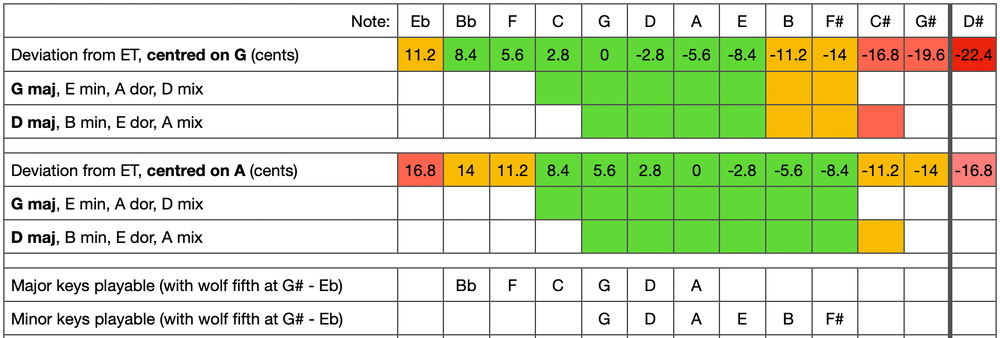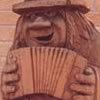Search the Community
Showing results for 'meantone'.
-
I'm looking to tune a concertina in 1/5 comma meantone centered around D and having A as close to 440 as possible. Could someone knowledgeable on the subject explain how to exactly go about this? Was wondering if anyone has a chart of the frequencies in Hz. Or if someone could explain how to create this. I've searched all over and find it generally confusing to understand how to construct it. Do I flatten the 5ths by a syntonic comma in the following order: D-A-E-B-F#-C#-G#-D#-A#-F-C-G ? And then half or double the resultant frequencies into their respective octaves to make up the scales and correct notes on the keyboard? Hoping to wrap my head around this subject. Thank you.
-
I just ran into some fascinating questions on another forum as I was trying to get my head around how to calculate frequencies for a 1/4-comma meantone scale given a reference note. Since Anglos have two "home" keys... Which reference note would I use? on a C/G Anglo, would I use C as the reference for the whole thing? OR, would I use C for the C row, and G for the G row? OR would I use C for the C row and THEN use the C row's G as the reference note for the G row? Or something else? and what about the accidental row? Is there some standard way of tuning an Anglo to 1/4-comma? Or does everyone have their own preferred way?
-
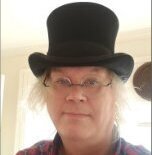
How did you find your way to concertina?
Allen Garvin replied to Capitanya's topic in General Concertina Discussion
I'll make my first post on the site here! November 4, 2 months ago, I saw a clip of someone playing a Wren C/G anglo on XTwitter, did about 20 minutes of research on if it was an instrument worth getting, and ordered one. I'm another serial instrument trier, and I'm the king of impulse music purchases. 2 solid months of playing it and loving it, I'm satisfied I'll stick with it, and will probably upgrade to something decent in the next 3-4 months, perhaps a Wakker. Previously, around 1996, I tried a cheap 20-button Stagi bought from Elderly, when they used to sell things beside guitars. It was a terrible instrument. I eventually took it apart to try to improve it, and failed, and didn't revisit the Anglo until 27 years later. I'm primarily a bowed string player, mainly the viol, which I've got about a dozen, and also rebecs, a vielle, violin family, even a recent lira da braccio... Btw, here's a video from 2022 where Gene Murrow on an Wheatstone English tuned to 415 was accompanying us in a viol consort: [Instgram, VdGSA Conclave] (I was filming, so not shown). I was wondering, when I upgrade, if it's possible to get something custom tuned in 415 in 6th comma meantone, but I'll probably put that off till later! Allen -

Big list of Anglo layouts
Luke Hillman replied to Luke Hillman's topic in Instrument Construction & Repair
More or less. Originally I was going to spell all notes as sharp by default, but after looking at a lot of layout diagrams in several tunings, Bb was pretty consistently spelled Bb. I know this won't be the case for some meantone-tuned instruments. I haven't discovered any clear conventions for note spellings in a given tuning, and I have yet to come up with a good way to preserve user preferences on which spelling to use for a given note. Your input definitely welcome! -
I’m selling an excellent Wheatstone G/D anglo. I acquired this early 1900s anglo from Greg Jowaisas. The serial number has been worn down to the point where it is not legible, and there are no numbers inside to help date this instrument. It has a seven fold bellows in excellent shape with no patches inside or out. I believe the tuning is one of the meantone ones but I don’t know enough about them to be sure. In any case it has a beautiful, rich tone. The layout is Jeffries but the original reeds to put it back to Wheatstone layout and a case are also included. Asking $7,500 OBO. The concertina is in Tryon, NC south of Asheville. Contact Ross Schlabach at rpsqueezer)a-t(gmail.com for more info, additional photos or with questions. Donation to C.net if sold here.
-
I think Stephen is right and the reeds are nickel silver - which I was surprised to find has no silver in it - usually 60% copper, 20% nickel and 20% zinc. They are less tarnished than brass reeds would be after 160 years! I also see why he suspected an accordion tuner - there are longitudinal tuning scratches on some reeds. I have it working sufficiently to evaluate the tuning somewhat, though not all reeds are speaking and some are odd. Firstly it's not in equal temperament - G# and Ab are quite different, as are D# and Eb. In general, the flats are sharper (+35 cents), and the sharps are flatter (-7 cents) than ET. So it was probably in a meantone temperament, likely quarter-comma meantone. I also think Stephen was right regarding Society of Arts pitch - the various A notes seem to be multiples of 222.5, so A=445, which is apparently the modern interpretation (for ET) of their C=528. Indeed middle C push is exactly 528 (the pull is odd/warbly). However a few other notes are 30 cents high, so maybe it was originally in high pitch and the tuning down to middle pitch was incomplete. I need to continue fettling (replacing pads etc) to get it properly playable to investigate the tuning further. I think I will keep it in a meantone tuning - I like the fifth-comma meantone centred on A that I applied to another old instrument - see https://pghardy.net/concertina/lachenal_27590/lachenal_27590.html which has a detailed description of what and why. Could anyone currently replace the tongues of three reeds with nickel silver tongues? As I said before, two reeds (C and G) seem to have steel tongues, and I just found out that one note (F) which was silent has a badly cracked reed. I have temporarily replaced it with a spare brass reed, but for a posh instrument like this it would be good to keep the original reed shoes and consistent tongue material. Any suggestions?
-
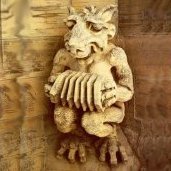
1/4-comma meantone calculation for Anglos
David Barnert replied to Luke Hillman's topic in General Concertina Discussion
The question was not what frequency should A4 be tuned to, but what key should be favored in the 1/4-comma meantone temperament (and should the two rows of an anglo use different 1/4-comma meantone temperaments). The two can be answered independently of each other. No matter how you structure the 1/4-comma meantone temperament (ie., where you place the wolf tone) in a given key, you can still tune the whole scale up or down an arbitrary constant amount so that A4 lands on 440 (or wherever you want it, as @alex_holden points out). -

1/5 comma meantone - how do I tune it?
Paul_Hardy replied to odonovanchris's topic in Instrument Construction & Repair
No, I agree that it seems odd, but see https://en.wikipedia.org/wiki/Meantone_temperament which says " Equal temperament is roughly the same as 1/11 comma meantone tuning". The key (I think) is that ET is 12 lots of the Pythagorean comma, but is only 11 lots of the Syntonic comma. The Pythagorean comma is the small interval in Pythagorean tuning between two enharmonically equivalent notes such as C# and Db. The syntonic comma is the difference between the Pythagorean tuning and Just tuning of the major third. Meantone tuning definitions are derived from Just tuning, using the Syntonic comma. In Pythagorean tuning, two half tones don't equal a whole tone. In Just tuning, there are two sizes of whole tone. As a useful web resource, see https://mathcs.holycross.edu/~groberts/Courses/MA110/Lectures/PythScale-web.pdf. I agree that this is a very confusing topic, and I barely manage to understand it. If I get time tomorrow, I'll follow up with a bit more explanation. Or are there any tuning experts here who can explain more clearly than me? -
I am currently at the stage of tuning the reeds for a new Anglo concertina. I have been reading, on this forum and elsewhere, on the various meantone tunings peope are using, especially on Engish concertina. I have the data I need for ET, 1/4 Comma and 1/5 Comma cent offsets, and I would like to know whether they offer any advantage in group playing. The tuner I use has the capabity to play chords and instantly switch to any other tuning. To my ear 1/5 Comma sounds much more harmonious than 1/4 Comma or ET; the 3rds and 6ths benefit greatly from the lack of beating. Would there be any benefit in applying meantone tuning to an Anglo to be mainly played in sessions/with other instruments? Your comments and insights would be appreciated. Mike
-
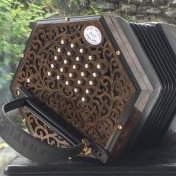
1/4-comma meantone calculation for Anglos
Little John replied to Luke Hillman's topic in General Concertina Discussion
I agree with everything in this post except for that last paragraph, quoted above. 440 refers to the frequency in Hz (or cycles/second). 5.6, 8.4 etc. in the table refers to cents, i.e. hundredths of a semitone. They don't mix. The first row shows that if G (in meantone tuning) is tuned to be exactly the same frequency as G in Equal Temperament tuning, then A will be 5.6 cents flatter than the A in ET. If you tune all the notes up 5.6 cents to make the A in meantone match the A in ET you simply end up with the second block in the table. The purpose of the table is to illustrate that matching A to the A in ET minimises the discrepancy between mean-tone tuning and equal temperament in the keys from two flats to four sharps. -
I ask myself the same question any time this is brought up - I altered all of my EC treble concertinas (apart from one tuned to meantone) the way you‘re suggesting. The baritone already had solder attached to the G#, and all I had to do then was swap the reed with the Ab one - and that’s how your OT remark can be transformed into supporting the sale: Buyer wouldn’t need to apply solder him- or herself, as this had already been done, so leave it as is or just swap the two reeds with (almost certainly) identical reed shows. Good luck with the sale! 🐺
-
Splendid! It reminds me a "régale", a reed instrument close to the organ. The meantone is perfect with this kind of music. Bravo!
-

1/5 comma meantone - how do I tune it?
David Barnert replied to odonovanchris's topic in Instrument Construction & Repair
Nice, but one small point. From your page: Shouldn’t that be 1/12 comma meantone? The comma is divided equally between the 12 intervals of the chromatic scale. -

1/5 comma meantone - how do I tune it?
Paul_Hardy replied to odonovanchris's topic in Instrument Construction & Repair
I've done some updates to https://pghardy.net/concertina/lachenal_27590/lachenal_27590.html to clarify the sections on 1/5 comma meantone. -

1/5 comma meantone - how do I tune it?
Paul_Hardy replied to odonovanchris's topic in Instrument Construction & Repair
I've retuned two instruments to 1/5 comma meantone, and wrote up what I did at https://pghardy.net/concertina/lachenal_27590/lachenal_27590.html#fifthcomma -
I have a brass-reeded Aeola TT which I use for song accompaniment. I used to use it for playing Nordic dance music but TBH the reeds quickly went out of tune. Now it awaits being retuned to 1/4 comma meantone.
-
1/4-comma meantone calculation for Anglos
bax replied to Luke Hillman's topic in General Concertina Discussion
Wally Carroll made me one in 1/5 comma meantone with the wolf at G#/D# and meeting A=440 at D. It's lovely, plays well with others, and the major thirds are juuust enough prettier for me to notice. I'll see if I can tack on a pic with the details. ... The wolf interval is not available on the instrument anywhere -

1/4-comma meantone calculation for Anglos
adrian brown replied to Luke Hillman's topic in General Concertina Discussion
Thanks Clive, I think that outside of the obvious clashes I highlight in the video, that occur when you push to the limit of meantone tuning, there's probably much less in it than a lot of people think. You can certainly get used to either, or both and it certainly shouldn't be something that gets in the way of the music! As I pointed out in the video, it rather depends on the sort of repertoire you want to play. In folk and pop music where parallel fifths are quite acceptable, the cleaner fifths you get with ET is probably a better option. In Renaissance and Baroque music where thirds were a consonant interval, and parallel fifths an aberration, MT is the obvious choice. Adrian -

1/4-comma meantone calculation for Anglos
adrian brown replied to Luke Hillman's topic in General Concertina Discussion
Probably best to simply share my calculations. A. Meantone temperament calculations for anglo concertina.pdf -

1/4-comma meantone calculation for Anglos
adrian brown replied to Luke Hillman's topic in General Concertina Discussion
Me too Little John! I have been using 1/4 comma meantone on most of my Anglos for many years and they are all tuned from the root A-440Hz. I have Anglos in CG, BbF, GD FC and baritone CG sizes, so if I had not done it this way, they would have been out of tune with each other. With each size, the wolf is simply shifted around the circle of fifths so it falls on the same button combinations on each instrument and I have one enharmonic note which sounds different on the press and draw (eb press - d# draw on a CG) effectively giving me one extra key possibility. As Sean pointed out, if you use a different root on each row, the instrument will be out of tune with itself, so it's a really, really bad idea. I have played many times with other instruments in ET and never had a problem, although you can hear the difference, particularly if you play with another concertina. In a group of more concertinas it's unlikely to be problematic because it's unlikely the concertinas themselves are all perfectly in tune and the blend of the different instruments will hide many discrepancies. Some years ago, I made a rather convoluted video to illustrate the difference between MT and ET, by playing the same pieces on both. (https://youtu.be/HT9fStxlbBQ) I had always meant to follow it up with another showing two or more concertinas playing together. I've somehow never got around to it because of the editing involved, but if there is a feeling this could be interesting, I might try and knock one up. Adrian -

1/4-comma meantone calculation for Anglos
Little John replied to Luke Hillman's topic in General Concertina Discussion
To illustrate my earlier comments, here is a table I constructed when I was considering fifth comma meantone tuning for my Crane duet. It compares aligning G with ET with aligning A with ET. It shows how if G is aligned, the commonly used C# and G# are starting to differ from ET by amounts that could be audible in some circumstances; and D# is even worse. [Less than 10 cents difference is generally considered not noticeable whilst 20 cents is considered noticeable. Opinions differ as to where in between it starts to become noticeable. No one has ever commented on the tuning my fifth comma tuned concertinas aligned ("centred") on A.] The wolf fifth is assumed in this table to be at Eb - G# (so you wouldn't have the D# except on an English concertina). Shifting the wolf fifth to Bb - D# would give a D# at the expense of an Eb. -

1/4-comma meantone calculation for Anglos
Luke Hillman replied to Luke Hillman's topic in General Concertina Discussion
Good question -- I don't know! I suppose, if so, that you'd want the whole keyboard tuned that way, instead of using different reference tones for each row...? I had assumed that the playing styles most likely to benefit from meantone temperament are ones that make heavy use of harmonies and chords, which is not something I think of when I think of Irish music, though I've heard—can't remember where—that quarter-comma is popular among Irish concertinists. Irish isn't my scene, though, so I'll wait for someone more knowledgeable to explain. -
Amboyna Wheatstone 48 key English for sale serial number 1008 from 1845. The Wheatstone Ledgers record the first owner as “Lady Hartland”. This is a beautiful concertina from Wheatstone’s early years as a manufacturer. It is finished in a beautiful amboyna veneer and has nickel silver reeds in brass frames. It plays with a sweet mellow tone. In 2020 it was returned to playing condition after extensive work by Colin Dipper. It is in it’s original quarter comma meantone tuning. Priced at £1100 or very near offer. More photos on my website
- 1 reply
-
- 1
-

-
This is a long shot, but... Has anyone managed to configure Thumbjam to play 1/5 comma meantone? If so, how did you do it? Thx. Don. Background (warning - rather geeky/anoraky) Thumbjam is a midi synthesizer/sampler app for iOS (iPad/iPhone). Michael Eskin donated his concertina sound samples to the developer of Thumbjam so you can play Michael's concertina sounds in Thumbjam. Major thirds on this system sound like major thirds on a real concertina. So I thought that this would be a good platform to experiment with meantone temperament. Thumbjam, being a synthesizer/sample player, can change the pitch of notes being played. There are very many scales/temperaments provided in Thumbjam besides ET and the common western scales but, AFAICT, no meantone temperaments. However, you can enter your own scales and, I think, temperaments. Thumbjam recommends a program called Scala to do this. I think, but I am not sure, that I can see a way to do this, but it is going to take me some time to figure it out so I am hoping that just maybe somebody else has been down this road already.
-

Quarter Comma Meantone - What Root Note?
Terry McGee posted a topic in General Concertina Discussion
A friend is porting Flutini, the real time tuning analyser, to iPod. I recounted that I'd found it useful for checking concertina tuning, and that some concertina players have gone for quarter comma meantone rather than equal temperament, so that if he were intending to offer some temperaments, that would be a potentially useful one. He agrees but asks what root note the temperament should be centred on. Do we have a firm view on this? Terry- 37 replies
-
- Temperament
- meantone
-
(and 1 more)
Tagged with:

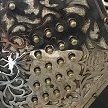



.thumb.jpg.23b6fcf34553f5a5db9b762a831724d9.jpg)


.thumb.jpg.e5ef9a111c1064c0bbea848f22aab7fe.jpg)

